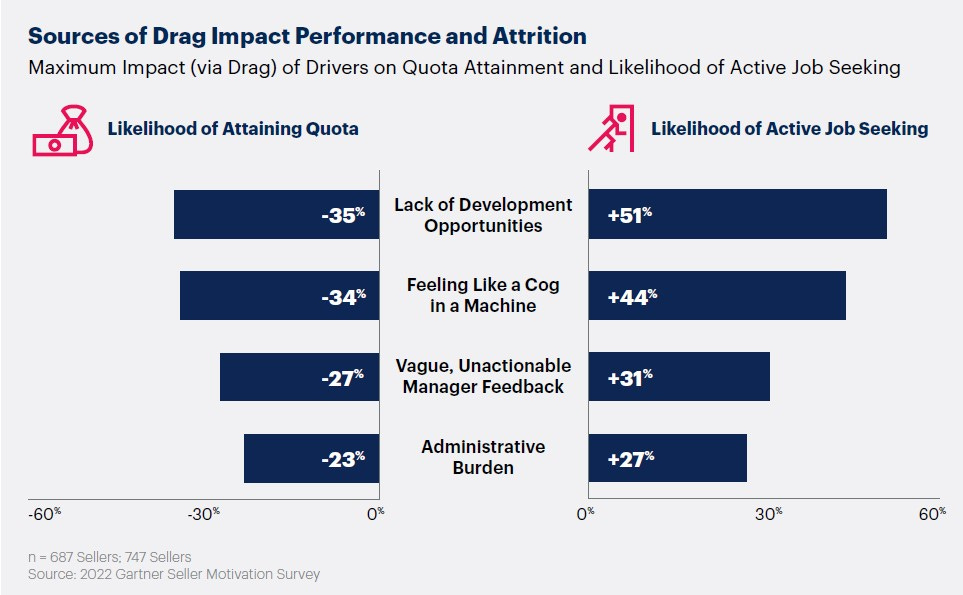Turning challenges into opportunities: a Sales Leader’s guide to retaining top talent
The end of the year. For many, it means the stress associated with the last quarter—while half of your colleagues are on leave, and probably your customers too. Good luck with that.
I came across a document titled “How to Motivate and Retain Your Sales Team” from Gartner (2022) and thought I’d share some of their insights. Buckle up, because the numbers are… well, you’ll see.
Before we dive in, let's clarify that the study refers to “Sellers” as a broad and generic term (a.k.a. Salespeople or Reps). The differentiation between B2B and B2C, or even the precise role (SDR vs. Account Manager, for example), does not seem to affect the findings.
The findings
Let’s begin:
“80% of Sellers are satisfied with their compensation” (always good to start with a positive note)
“89% of Sellers feel burned out”
“54% are actively looking for a new job”
“59% think their management does not understand how to motivate them”
“67% feel that leadership is overly optimistic and disconnected from their reality”
Interestingly, and contrary to what we might expect based on the above data, 76% of Salespeople report a "high drive", defined as “motivation toward work that manifests in being engaged, ready to act, mentally alert, and persistent in the face of obstacles”. So, that’s positive news. Maybe it’s related to a natural trait of a good Rep—something intrinsic that keeps them pushing forward even in tough times.
While the challenges are clear, the opportunity lies in how leadership can engage and empower their teams to address these issues. The focus should shift toward driving purpose, motivation, as well as development opportunities - areas where Executives and sales leaders can have the most impact.
The challenge lies mostly with what Gartner calls the “drag”- the demotivation away from work. It manifests as procrastination, feeling bored, avoiding work, struggling with focus, and just going through the motions. 17% of Reps report a “low drag,” meaning that the vast majority report either medium or high levels of drag. The level of drag seems to correlate directly with quota attainment, burnout risk, and the appetite to look for something else.
Factors that contribute to an increase in “drag”
Gartner identifies four main factors that contribute to an increase in “drag”:
“Lack of development opportunities”
“Feeling like a cog in a machine”
“Vague, unactionable manager feedback
“Administrative burden”
Now, this is where leadership can step in and make all the difference.
Regarding the first one—development opportunities—creating clear paths for growth is not just a “nice-to-have” but an essential part of keeping top talent engaged. High-performing salespeople thrive in an environment where they can see how their career can grow, so investing in ongoing professional development is key to retention. As an Executive or sales leader, it’s important to lead the charge in creating opportunities for career progression. You can start by providing clear, structured development plans that are tailored to individual strengths. You might want to read Ladder vs. Lattice: rethinking Sales career growth
As for the second one—creating a sense of purpose within your team—this is a critical area for leadership to address. We’ll dive into this in a future article that focuses more on culture, but suffice to say that salespeople who feel like they are working toward a bigger mission, and who understand the "why" behind their work, tend to be more motivated and less prone to burnout.
When it comes to manager feedback, this is where Executives and leaders can create a culture of clear, actionable, and positive reinforcement. Having the right tools, training, and frameworks for managers to provide specific and constructive feedback is critical. When feedback is vague or overly critical, it can exacerbate the drag. As Leaders, empowering your management team with the right resources to guide and mentor their direct reports will have a ripple effect on performance.
Finally, addressing the administrative burden—this is a real challenge for sales teams, and one that can easily be overlooked at the executive level. Ensuring that salespeople can focus on what they do best—selling—is a priority. Reducing non-selling activities and implementing tools and systems that streamline administrative tasks will help increase efficiency and job satisfaction. You might want to read Selling vs. Non-Selling activities: where do we draw the line?
At this point, it’s up to you, as a Leader, to decide how you perceive these findings and how you can turn these challenges into opportunities. Let’s explore why these insights can be “positive” for you as a sales leader.
Why Positive?
Simply put, the numbers are concerning. Sales is a tough job, and turnover is high. But ignoring these issues won’t help anyone. If the situation in your company or industry is different, that’s fantastic! In that case, take these insights as a way to double down on what you’re already doing well. If not, addressing these concerns head-on is an opportunity to evolve your team into something even stronger. It’s all about taking proactive action.
In addition, acknowledging challenges is the first step to tackling them. Once you understand the root causes, you have the power to fix them. As a leader, you now have a clear map of where to focus your attention. Whether it’s improving development opportunities, offering more purpose, giving clear feedback, or reducing the administrative load—each of these is an opportunity to lead your team to greater success.
So, while the statistics might seem alarming at first, they’re not just a reflection of the issues at hand—they’re a call to action. By taking a proactive, empowered approach, you can address these challenges head-on and position your team for long-term success. Embrace this opportunity to create a high-performance sales culture, and you’ll be well on your way to retaining your best talent and driving outstanding results.





